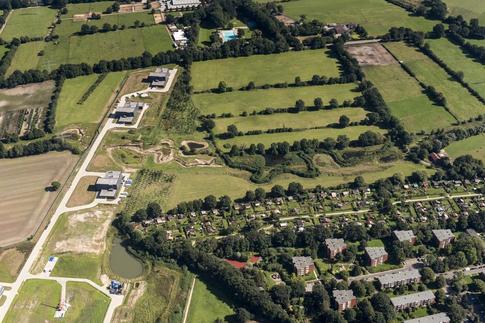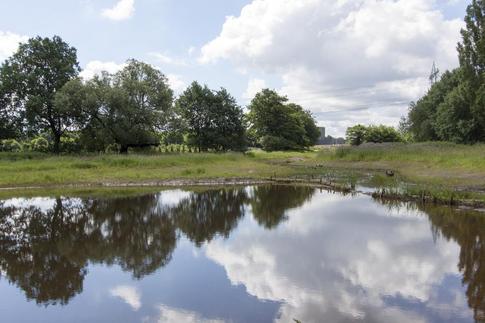XFEL: European XFEL brings Düpenau back to nature
European XFEL brings Düpenau back to nature
After a restoration effort funded and coordinated by European XFEL, the portion of the stream Düpenau in the vicinity of the future X-ray laser’s site now has renewed natural banks and associated wetlands. The Düpenau was running for more than 130 years of creek regulation through an artificial channel along the border between Hamburg and Schenefeld.
The regions surrounding the European XFEL site, called the Osdorfer and Schenefelder Feldmark, contain centuries-old ecological areas that are rich with plant diversity. The Düpenau feeds water into the area, and sometime around 1880, the stream was modified into a straight canal when the Feldmark was converted from a peat bog into farmland.

Aerial view of part of the southern portion of the new natural areas and part of the European XFEL research campus in September 2016. The city of Hamburg had previously restored part of the DÃŒpenau seen to the right; to the left, the newest of the restored banks for the stream are visible. Several hedgerows and meadows are also visible towards the middle and top of the picture.
After the restoration of over a kilometre of its length, the Düpenau now meanders through the pastures between Hamburg and Schleswig-Holstein, with natural banks that can better accommodate frogs and a type of semi-oceanic fish called the stickleback. Beyond the new riverbanks, European XFEL is restoring wetlands surrounding the facility’s sites, including a wooded marsh and areas of canebrake, forming basins for both groundwater and above-ground water retention. Work on the Düpenau’s banks had already been completed by the city of Hamburg in the regions north and south of the European XFEL sites.

One of the restored wetlands north of the European XFEL research campus, which can be partially seen behind the trees, in July 2016. The restored DÃŒpenau can be seen flowing into this pond through a canebrake. These areas provide new habitats for various species of frogs, birds, and semi-oceanic fishes.
The trees and shrubs in the hedgerows create borders for old meadows, like those used as habitat for the northern lapwing, a plover species that has seen large declines across its range in Europe over the past three decades and is listed as a “Near Threatened” species by the International Union for the Conservation of Nature and Natural Resources. Birds, such as swifts and martins, and Nathusius’ pipistrelle, a type of small insectivorous bat, find good habitats in the hedgerows, which also host many flowering plants that attract pollinators like honeybees. One of the new hedgerows runs alongside a new pedestrian trail linking the European XFEL main entrance in Schenefeld with other trails that lead to Schenefelder Holt across the border in Hamburg.
In the last stages of renaturation, European XFEL has been planting more trees and shrubs, including local species like silver birch, European beech, ash, and oak, across its main research campus. The plants will provide nesting opportunities for numerous different birds and other local wildlife, making the site of a worldwide leading research facility a very attractive place for local nature to thrive. Further extensive plantings will take place from fall 2016 to winter 2017.
